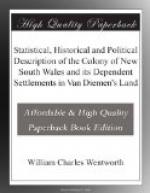in a flock. With regard to the value of the wool
grown in this colony, the last importations of the
best quality averaged five shillings and sixpence per
pound in the fleece. This was sold last month;
[March, 1819] and as the market was at that time overcharged,
and as moreover the best description of wool yet produced
in this colony, is far from having attained the perfection
of which it is capable, and which a few more crosses
with the pure breed will undoubtedly effect in it,
it may be safely concluded, that this is the lowest
price at which this sort of wool will ever be sold.
This will be more evident, if we contemplate the gradual
rise in value, which the wool from the same gentleman’s
flocks has been experiencing during the last four
years. In 1816, it was sold for 2s. 6d. per pound
in the fleece; in March, 1818, for 3s. 6d. per pound;
in July, 1818, for 4s. 4d. per pound; and in March,
1819, for 5s. 6d. per pound in the fleece. For
some of this last quantity of wool, properly sorted
and washed, Mr. Hurst of Leeds was offered 9s. per
pound, and refused it. To take the future average
price of wool at 5s. 6d. per pound, is, therefore,
forming an estimate, which in all probability will
fall far short of the truth. However, let this
be one of our data; and let us allow three pounds,
which is also an estimate equally moderate, as the
average weight of each fleece. The weight of
a yearling’s fleece may be taken at three quarters
of a pound, and the value of the wool at 2s. 9d. per
pound. The number of ewes generally kept in a
flock by the best breeders are about 330, and we will
suppose that the emigrant has the means of purchasing
a flock of this size of the most improved breed:
this with a sufficient number of tups may be had for
L1000. These points being determined, let us now
proceed to our calculation.
[Table not included in this text version—see
html version. Ed.]
It would be useless to prosecute this calculation,
since any person who may be anxious to ascertain its
further results, may easily follow it up himself.
It will be seen that with the most liberal allowances
for all manner of expenses, casualties and deteriorations,
capital invested in this channel will yield the first
year an interest of 131/2 per cent. besides experiencing
itself an increase of nearly 24 per cent.; that the
second year it will yield an interest of nearly 25
per cent. besides experiencing itself a further increase
of rather more than 371/2 per cent.; and that the
third year it will yield an interest of nearly 37
per cent. besides experiencing itself an additional
increase of about 421/2 per cent. or, in other words,
money sunk in the rearing of sheep in this colony will,
besides paying an interest of about 751/2 per cent.
in the course of three years, rather
more than double itself. Here then is a mode
of investing capital by which the proprietor may insure
himself not only an annual interest, the ratio of




